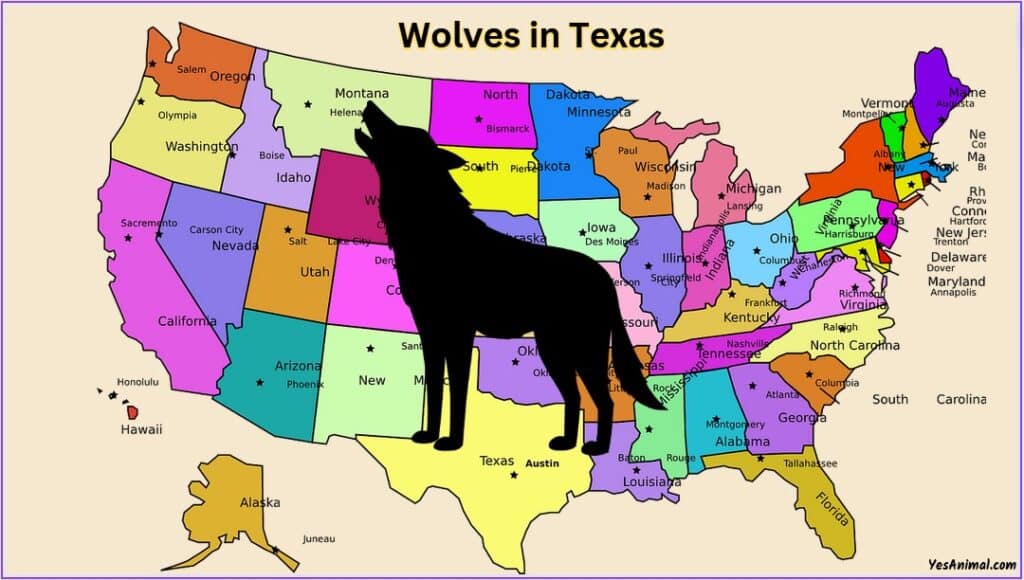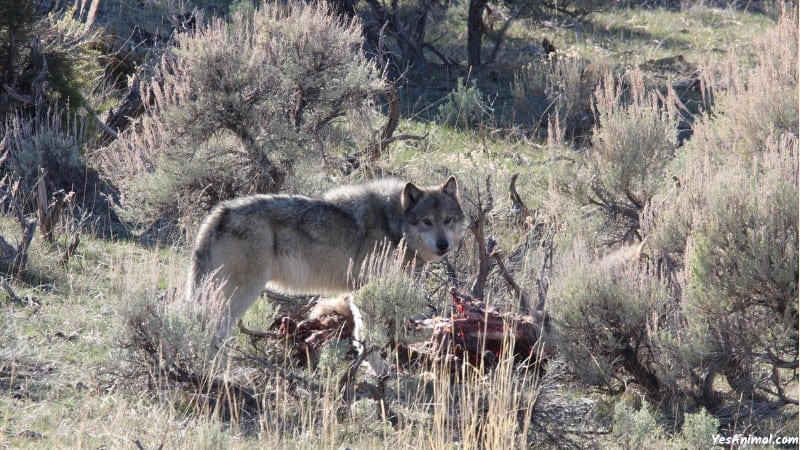Last Updated on September 14, 2023 by Amin Tawar

Wolves flare both fear and adoration in the hearts of people. Their sharp stares, fierce stances, and electrifying howls are outright enchanting. However, meeting them in the wild, you will only catch their sharp teeth and shining eyes.
Luckily, when in Texas, you need not have to bother about coming head-to-head with a wolf, at least for now. So, it is really not possible to meet one in Texas?
So below I’ve explained all things you need to know about the Wolves in Texas, so without further ado, let’s get started!
Are There Any Wolves In Texas?
Presently, in Texas, there are no wolves. Previously, in Texas, there were two species of wolf: the gray wolf and the southeastern red wolf.
A subspecies of gray wolf known as the Mexican gray wolf was also found. However, in 1967, gray wolves were recorded as endangered species, and by 1970, even the gray and red wolves were extirpated in Texas. Mexican gray wolves became extinct only in the late 1980s.
The only place in Texas where wolves can be spotted is The Saint Francis Wolf Sanctuary in Montgomery as it is home to about a dozen saved wolves or wolf-dog species.
The red wolves are average-sized species with reddish coats. They are native to the U.S., and studies conclude they are a distinctive breed.
They were once found in the Southeast, from New York to Texas, habitant in coastal plains and marshes. Their diet consists of elks and small animals.
The Mexican gray wolf, also known as Lobo, is a species of gray wolf that is native to regions of New Mexico, Mexico, Arizona, and Texas. It’s differentiated from the classic gray wolf by its slim head, yellowish-gray coat, and size. They are the smallest species among the North American gray wolves.
Are Wolves Endangered In Texas?
Yes, wolves are endangered in Texas. Prior to the Civil War, gray and red wolves were plentiful in Texas. They intrinsically split their packs, with gray wolves in the west and red wolves in the east. In fact, gray wolves were so abundant they inhabited most of the northern region.
During the mid-1800s, wolf coats became famous, and hunters will kill off a big number of wolves at a single time with poison sprinkled on buffalo.
Buffalos disappeared in the late 1800s, and wolves began feasting on livestock. This made their numbers so numerous that the government began paying tips to decrease their population.
The US Biological Survey, in 1915, created a predator control program concentrated on decreasing wolf numbers. They believed they must deploy in-depth steps “Until the final animal is hunted down.” from 1915 to 1966, over 34,000 wolves were killed in Texas.
In 1970, the final two gray wolves were killed by hunters and the remaining few red wolves were caught and sent to a breeding project.
Periodically, people register to notice red wolves in Texas, but officers stated that they are coyote hybrids and not genetically real wolves.
Will Wolves Be Reintroduced To Texas?

Wolf restoration measures have persisted for years in Texas. Environmental parties have attempted to persuade the state to reintroduce them into Big Bend National Park.
The approval of political authorities obtained considerable awareness of the problem, but stakeholders chose not to get wolves in the national parks of Texas. Rather, officials have concentrated on releasing them into regions of New Mexico and Arizona.
Though there is an abundance of suitable habitats for wolves in the state, Texas has no ideas to reintroduce them, earn stakeholder approval, or work on rehabilitation projects in the Chihuahuan Desert. There are a bunch of large places for wolf habitats on public and private land, whereas political will is absent.
Also Check Out Our Guide On Wolves In Montana
How Big Are The Wolves In Texas?
The red wolves are four feet in length, about 26 inches tall, and weigh 45 to 80 pounds. People often misinterpret them for coyotes, but they are extremely larger. Their diet consists of elks and small animals.
However, it’s crucial to document that individual wolf sizes and weights can differ significantly relying on aspects such as sex, age, and food availability. It is also important to note that coyotes can occasionally be misperceived as wolves.
Can You Hunt Wolf In Texas?
Hunting of wolves in Texas is illegal. Gray and Mexican gray wolves are documented as endangered animals under the Endangered Species Act and are guarded by the state. Trapping, hunting, or killing any wolves or other endangered animals can result in considerable fines and imprisonment.
Also, any killing or attempting to harm a wild animal like a lion, leopard, tiger, hyena, bear, wolf, or subspecies of these animals can be imprisoned in the state.
However, hunting of other gaming animals like coyotes and elks is permitted in Texas, but restrictions do apply, and hunting permission and a license are needed.
Can You Own A Wolf In Texas?
Owning a wolf without a certain permit in Texas is illegal. As Mexican gray and Gray wolves are protected under federal and state law, keeping them as pets can lead to imprisonment or fines. However, these permits are allocated for educational, scientific, or zoological intentions.
Additionally, it’s crucial to note that wolves can be dangerous as they are wild animals. They need specialized supervision, a big enclosure, and a distinctive diet, and can be hard to handle when captivated. So, owning a wolf is not advised, and it’s better to appreciate them in their natural habitat from a distance.
Also Check Our Guide On Wolves In US
Conclusion
And that was everything You Need To know about the Wolves in Texas. I hope this article answered all your queries.
Thank You For Reading!
Our Goto Source For This Guide